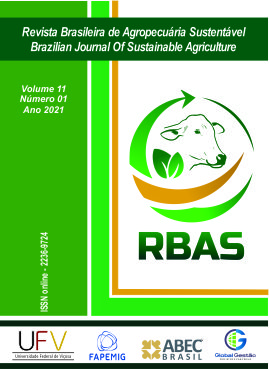DIFFERENT DENSITIES OF THE BRACHIARY IN THE PRODUCTIVITY OF THE CONSORTIUM CORN
DOI:
https://doi.org/10.21206/rbas.v11i1.12914Keywords:
Zea mays, ILP, No-till ConsortiumAbstract
The union of grain-producing crops with forage species is an option of the integration systems. The ILP is a conservation and sustainable system. The objective of this work was to evaluate the agronomic performance of corn, second crop, intercropped with Brachiara Ruziziensis, under different population densities. The experiment was conducted at Fazenda Padre João, Silvânia, GO. The soil was classified as Dystrophic Red Latosol. The experimental design used was randomized blocks, consisting of four treatments, four blocks and four replications. The treatments were the control and the consortium of corn with 6.0; 8.0 and 10 Kg ha-1 of brachiaria, with spacing between rows of 0.50 m, and an average distribution of 3.1 without linear m-1 with the intention of obtaining a final stand of 62 thousand plants ha- 1. In planting fertilization, 300 kg ha-1 of 05-25-15 were used, sequentially to brachiaria. In top dressing, 250 kg ha-1 of urea. The intercropping with brachiaria does not interfere negatively in the physiological parameters of corn. Brachiaria density in the intercropping with corn does not affect plant height, stem diameter, ear height and number of leaves of corn plants. The green mass is greater in single crops and for the intercropping the best performance is with 6.0 kg of brachiaria ha-1. For the purpose of corn grain production, the density of 6.0 kg of brachiaria ha-1 is the most suitable.
Downloads
Downloads
Published
How to Cite
Issue
Section
License
Copyright (c) 2021 Brazilian Journal of Sustainable Agriculture

This work is licensed under a Creative Commons Attribution-NonCommercial-NoDerivatives 4.0 International License.
1. Proposta de Política para Periódicos de Acesso Livre
Autores que publicam nesta revista concordam com os seguintes termos:
Autores mantém os direitos autorais e concedem à revista o direito de primeira publicação, com o trabalho simultaneamente licenciado sob a Licença Creative Commons Attribution que permite o compartilhamento do trabalho com reconhecimento da autoria e publicação inicial nesta revista.












